The Alaska Malamute or Alaska dog is a sled dog with a tall body, remarkable health and endurance. In the past, Alaska was raised mainly for traction for hunting and exploring new lands. Today, Alaska dogs are pets in many families. With a cute facial expression, Alaska can easily capture your heart from the first contact.
So is it difficult to raise Alaska dogs? How much does a purebred Alaska dog cost? If you are planning to raise this giant dog, please refer to the information that we will share in this article!
The origin and development calendar of the Alaska dog
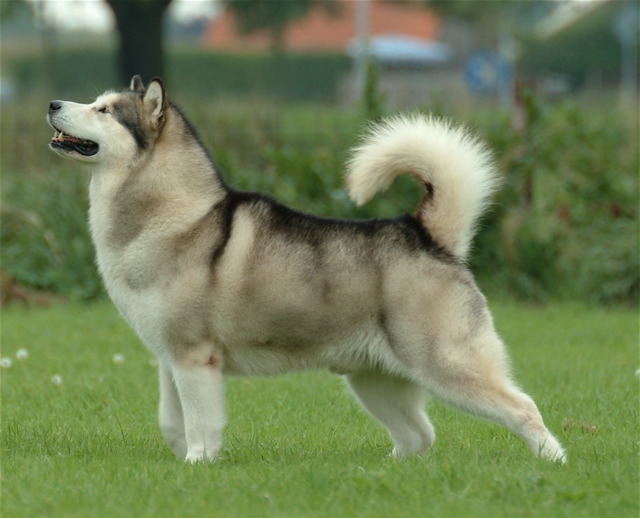
The Alaska dog of today is derived from an Arctic wolf breed. Following that, the Malamute people domesticated this wolf breed as a pet for production and housekeeping. However, it was the Eskimo nomads who identified Alaska’s exceptional health. Following that, the Eskimos started to cross-breed Alaska with other breeds like as Newfoundland and St. Bernard in order to develop Alaska lines that were more resilient, adaptable, and operated well in the Arctic’s exceptionally severe winter conditions.
When Alaska became an official US territory, the Alaska dog became the official dog breed of the United States of America. The Alaska breed was formally recognized as an unique breed by the American Kennel Club AKC in 1935. Alaska dogs have grown in popularity in the United States since then.
However, when World War II broke out (1940-1945), they chose the strongest Alaska dogs to serve in the war. Alaska was sent to combat on many battlefields. As a consequence, the population of this breed has been drastically diminished. Because the majority of the dogs transported to the war perished in the most intense conflict zones.
Many individuals became aware of the Alaska breed’s significant decrease after World War II. The survivors from Alaska were brought back to be bred. As a result, the population of Alaska has had the time to recuperate and flourish as it is now.
Features of the appearance of Alaska dogs
Because they are descendants of arctic wolves, if you see Alaska for the first time, you will feel they closely resemble wolves. The appearance of Alaska has many similarities with the Husky sled dog line. But the body of Alaska is much taller than Husky.
Height and weight
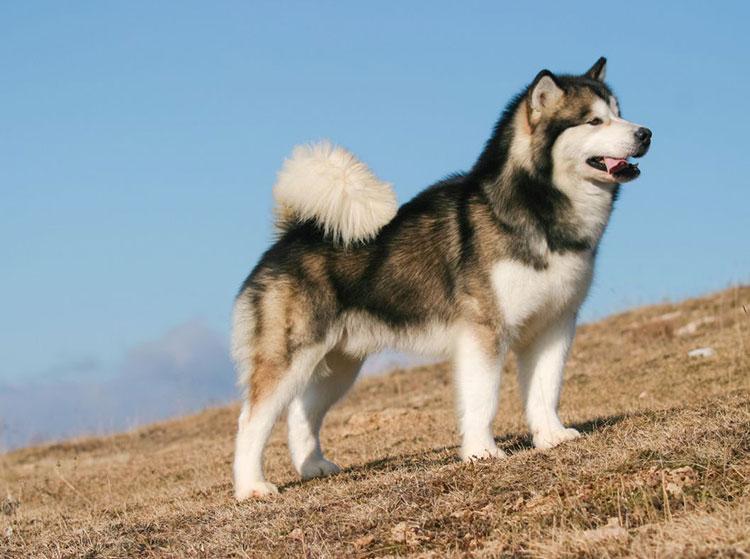
Each mature Alaska puppy will weigh 45 to 50 kg and stand 65 to 70 cm tall. With enormous Alaska dogs weighing up to 80kg and standing nearly 1m tall. This breed’s skeleton is rather big, with a well-balanced percentage of body components.
The Alaskanarticular system of their legs is highly robust and sturdy since they come from a line of sled dogs with tough health. As a result, these canines can navigate easily on snow levels up to a meter deep. This breed’s huge, toned build explains why they can labor relentlessly in minus ten degrees Celsius temperatures in the Arctic.
Fur characteristics
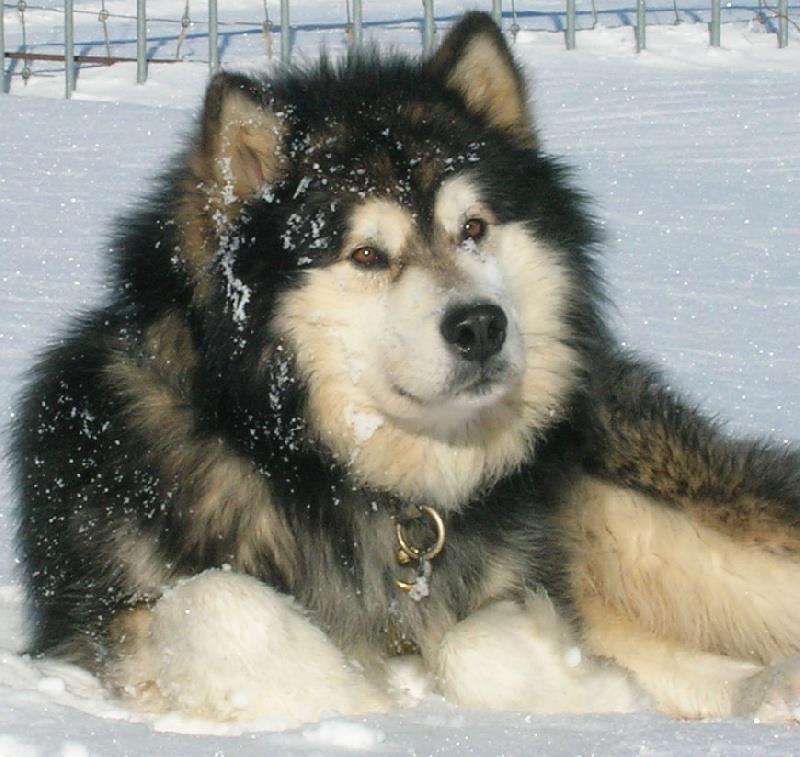
The coat of the Alaska Malamute is composed of two layers. In which the outer coat is very long, thick and waterproof. The inner coat is shorter than the side coat and has a structure similar to that of sheep, which helps warm the body of Alaska.
Alaska’s coat color is relatively diverse. But the most common are still the typical colors such as white-gray, black mixed with white, pink, copper-gold, chocolate color, .. Rarely made white coat color, very rare white Alaska dogs, the price will be higher than other coat colors. again. But regardless of the color of the coat, the 4 legs and snout of Alaska are always white.
Features of the first part
In addition to the thick coat, the feature that many people are most attracted to in Alaska dogs is their face. The face of this breed is relatively large with wide cheeks and broken nose. But thanks to these features, looking at the faces of Alaska dogs is extremely cute and funny.
Alaska has slightly slanted eyes, which look like almonds. The typical eye color of the Alaska Malamute is chestnut brown or black. Unlike the Husky’s eyes, which look very sharp, Alaska’s eyes are very gentle. In general, looking at Alaska’s stupid face is very cute.
Alaska’s ears are of moderate size, in proportion to the face. There are many soft hairs on the earlobes. Both the snout and nose of Alaska dogs are quite large. In particular, the dog’s nose is always pink in the middle and looks very cute.
Tail features
Alaska has a long curved tail with thick fur covering the outside. When moving, the Alaska’s tail is usually upright, not drooping like a Husky.
Classification of Alaska dogs
According to the American Kennel Club AKC, Alaska dogs will be classified into 3 main groups. Includes Alaska Giant (Alaska giant), Alaska Large Standard (Alaska large standard) and Alaska Standard (Alaska standard).
Alaska Giant (Alaska Giant)
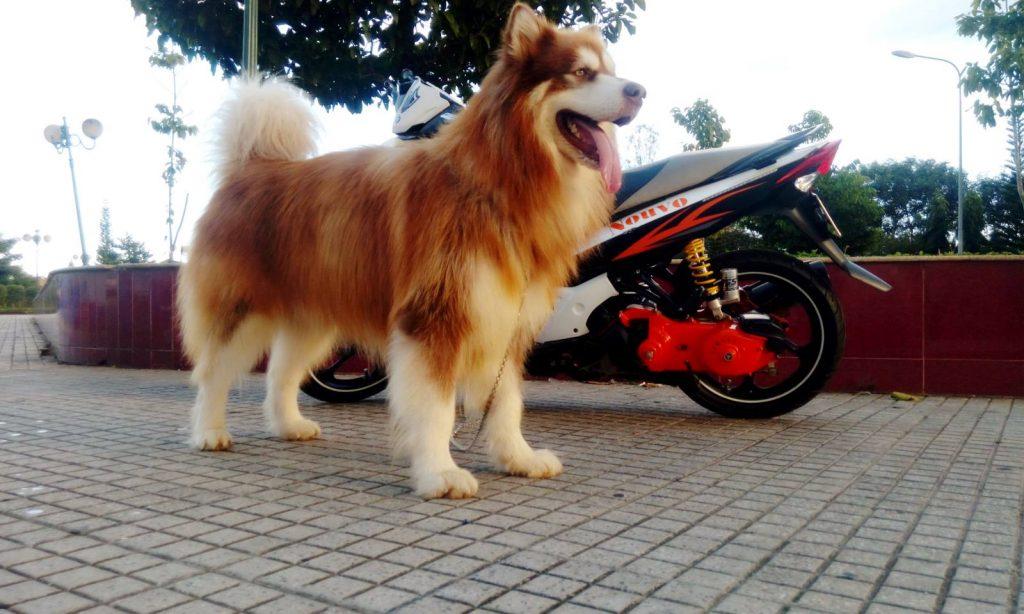
Among the three most popular Alaska lines today, this is the one with the highest body size. When mature, they may reach heights of up to 1m and weights of up to 80 to 90kg. They are generally the herd’s leaders, in charge of the smaller animals. The Alaska Giant is in good health. They can travel in cold conditions and transport a large volume of cargo and passengers.
The Alaska Giant can only live under cold weather conditions.
The gigantic Alaska stream does not always achieve its full size when grown in temperate areas, such as Vietnam. Furthermore, their fur is often ruffled, making them less attractive than Alaska Giant bred in cold areas.
Alaska Large Standard (Alaska Large Standard)
Alaska Large Standard has a body size to be slightly smaller than the giant Alaska line. They are born from standard parents and live in suitable conditions. Plus proper nutrition helps the body of the Alaska Large Standard to be larger than the standard Alaska line.
Standard Alaska dog
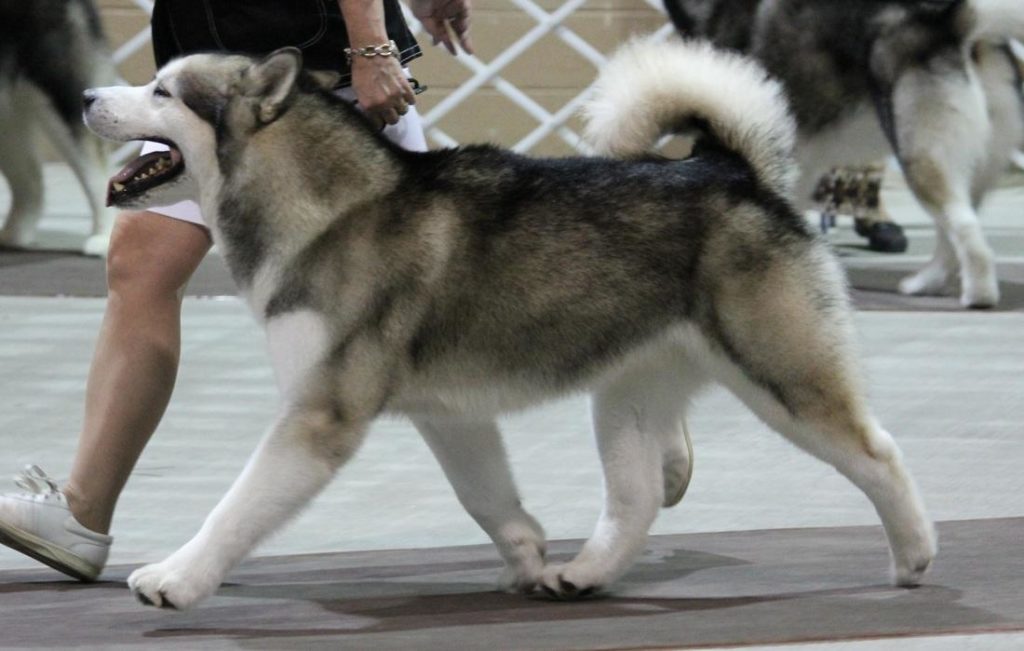
This is the most raised Alaska strain in Vietnam today. The height and weight of standard Alaska will be smaller than the two Alaska lines mentioned above. Each adult Alaska puppy will weigh from 36 to 43 kg for males, 32 to 38 kg for females. This dog breed has the ability to adapt well to Vietnam’s weather conditions, so their coat and body develop quite well.
Personality characteristics of Alaska dogs
The Alaska Malamute is a descendant of the wild arctic wolves. However, after many generations, the wild nature of the wolf ancestors has almost completely disappeared. Instead, it is a gentle, friendly personality.
Always loyal to the owner
The Alaska Malamute has very good herd behavior. When you raise Alaska from a young age, the dog will consider you like a “leader in the pack”, ready to carry out every command you give. Despite being a fairly friendly breed, Alaska are always aware of exactly who their real owners are.
If you have an Alaska dog, you should raise a dog from the time the dog is 1-2 months old. At the same time, helps dogs build relationships with family members. This way, the dog will always consider your family as the sole owner. Alaskas are inherently very gentle dogs, but when they see their owners threatened, they are ready to become aggressive, rushing to attack the enemy to protect the owner even if it means sacrificing their lives.
Smart, aware of problems
Alaska is very intelligent, dogs learn and execute commands extremely quickly. Besides, dogs also have a high thinking ability when they are aware of everything happening around them and their owners. Especially when realizing that there is danger lurking, dogs often have expressions such as constant barking, growling, and pulling on clothes, … Then you should observe carefully around because Alaska’s alert instinct helps dogs recognize dangers. very accurate.
With their intelligence and agility, Alaska dogs have become effective friends for people in Alaska on hunting trips and exploring new lands. The memory of Alaska dogs is very impressive, you will rarely see a stray dog except in the case of dog thieves. When the dog runs after the car, even though the bug is far away, the dog can still find its way home. Of course, in case bad things happen, you should still keep an eye on your dog at all times.
Very active and agile
Like some other sled dogs, Alaska is always full of energy. Dogs love to run, jump, play with their owners and friends. Therefore, every day, let your dog go for a walk in parks and large gardens. Do not keep the dog in the house for too long, it is easy to make the dog taciturn and stubborn. When being in a confined space for too long, dogs can become aggressive and destroy furniture to release energy.
Because it belongs to the line of sled dogs, Alaska loves to be active. Dogs love to play catch and pull heavy objects. Every day, let your dog jog a few kilometers or pull objects such as old tires, tree branches, .. This not only helps the dog to release energy but also makes the dog’s body more toned.
Gentle, docile
Despite possessing a relatively tall appearance, the soul of Alaska is no different from that of a child. Alaska puppies with innocent faces always know how to please their owners. When he wants something, the dog starts making cute faces by sticking out his tongue and turning his eyes upside down. At times like these, Alaska looks so in love. Or when angry, the dog will lie still and pretend not to care about what you say.
Although sometimes angry, aimlessly, a little stubborn, but Alaska is still a very obedient dog. As long as you give your dog real love, you will clearly feel how affectionate and obedient Alaska is. In addition to active games, teach your dog how to pack up after playing. Alaska is quite quick, everyone will understand what you instruct.
Be a great friend of children
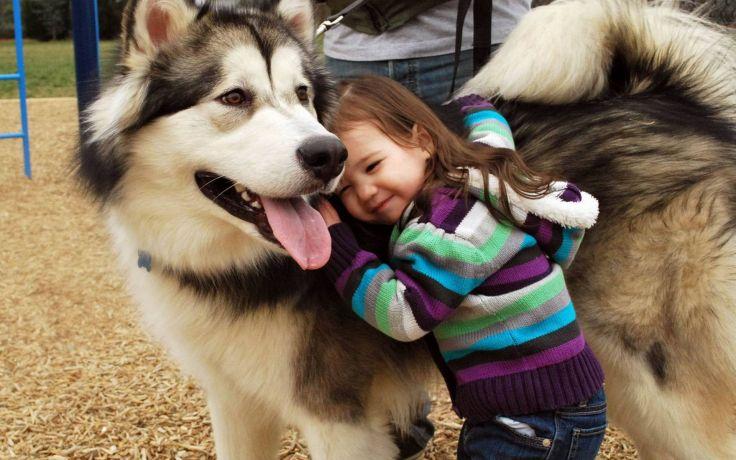
Alaska is very sociable and always appears friendly, especially with young children. When playing with the “little lotus”, the dog always shows patience when enduring all the children’s pranks. When next to the children, Alaska looks like a professional 4-legged nanny, ready to take care and protect the “little lotus”.
In addition, Alaska is very friendly with other family pets. If you raise a dog with the same cat, Alaska is like a big child who can only endure being bullied by the “little emperors”.
How to raise Alaska dogs
The Alaska Malamute is native to regions with cold climates most of the year. Therefore, if you raise Alaska in a place with hot and humid weather like in Vietnam, you need to pay special attention to the conditions of accommodation, nutrition and proper hygiene for the dog.
Suitable living conditions for Alaska
Alaska is a large, active dog breed. Therefore, the dog needs to live in a place with a large space to play in order to be able to make the most comprehensive distinction.
In addition, you need to note that Alaska is not good at enduring the heat. When the ambient temperature is too high, the dog is very susceptible to heat stroke. So, on summer days, you need to let your dog rest in a place with a cool fan or air conditioner, avoid letting the dog go out at noon. And you should also add enough water for the dog.
What do Alaska dogs eat?

Alaska dogs are quite voracious, almost anything you give the dog to eat. However, you should note, that Alaska dog food needs to give priority to protein-rich foods. Normally, protein will be abundant in red meats such as peanuts, beef, lean pork, chicken, and animal organs. Besides protein, groups of substances such as vitamins, fiber, and calcium are also essential for the dog’s digestive system and bone and joint development.
When Alaska puppies are 1 to 2 months old, you should feed them 4 to 5 meals a day. When the dog is older, the number of meals can be reduced to 2 to 3 meals/day. Although the number of meals is reduced, the amount of food in each meal needs to be increased to match the growing needs of the dog.
Like other dog breeds, Alaskas do not like to eat vegetables at all. But even if your dog hates it, you still have to train your dog to eat vegetables every day. The diet is only meat, but lacks vegetables, making it easy for dogs to become constipated due to a lack of fiber and vitamins.
In addition, you need to avoid giving your dog leftover, rancid food. When the dog has finished eating, wash the utensils for the dog to eat. Change the dog’s water about 3 times a day to prevent the water from being contaminated with dirt and bacteria.
Fur care for Alaska
Alaska’s coat is very long and thick, so it requires relatively sophisticated care. If possible, take your dog to a spa once a month. Besides, it is necessary to brush the dog’s coat regularly every day, especially during the shedding season. Especially in the summer, you should trim the dog’s coat so that the dog does not get hot.
With quite a thick fur, bathing for Alaska is also quite difficult. Bathe your dog 1 to 2 times a week. You do not need to bathe your dog often with water, but you can use dry bath powder.
Finally, it is necessary to clean up the place where the dog rests and plays. Even your dog’s toys should be cleaned weekly or weekly. Alaska is very active, so when playing with dogs, they often dirty their own fur. Therefore, when you let your dog out to play, you need to choose a clean place, without puddles such as the lawn.
How to train Alaska dogs
Besides paying attention to how to take care of Alaska dogs, you also need to pay special attention to dog training. Although Alaska is a smart dog, if it is not taught from a young age, the dog will be spoiled and disobedient. So right from the moment you pick up your dog, start training your dog with simple lessons. First you need to name the Alaska dog. A good, easy-to-remember name lets the dog know who he is and makes training easier.
To train your dog to obey requires a little patience and wholehearted love for the dog. Alaska is inherently very mischievous and active, so when you start training your dog, you may not be familiar with the rules you set. But with each lesson, let your dog do it many times, over time it will form a good habit for the dog. Every time the dog does well, you can reward the dog with food or by cuddling and praising. It’s simple, but dogs love it.
Sometimes Alaska is a bit stubborn, hard to do to attract people’s attention. At this point, you can be a little more strict so that the dog knows he is wrong and does not dare to do it again. But it is not necessary to use whips. Instead, it is through punishment such as forcing the dog to sit still and not play with his favorite toy. From there, the dog will know it’s wrong and won’t dare to disobey you anymore.
To limit the risk of obesity and help your dog’s body become more toned, give your dog exercise exercises to release energy. Such as jogging, type heavy objects. As a child, Alaska used to love to run after the car. So every evening, you can go slow and let the dog run. Don’t worry about your dog getting tired because Alaska is a labor line, so they are used to pulling cars and jogging.
For adult Alaskas, heavy lifting exercises are the most suitable. Dogs have the ability to pull heavy objects such as tires, weights, .. for up to an hour without showing signs of fatigue. Letting your dog pull is a way to help your dog release energy and make his muscles stronger.
Common diseases in Alaska dogs
Alaska dogs are in relatively good health, but sometimes dogs are still at risk of some common diseases. Such as parasitic disease, enteritis, heat stroke, eye disease.
7.1. Inflammatory bowel disease
The main cause of inflammatory bowel disease is some types of bacteria from outside entering the body of Alaska. That affects the intestines. In addition, an unsafe source of rancid food also makes dogs susceptible to diseases related to the intestinal tract.
When Alaska dogs have enteritis, they often have symptoms such as vomiting and abdominal distension. When you detect that your dog has such symptoms, you need to take the dog to the veterinary facility for timely treatment by the doctors.
Parasitic disease
The Alaska Malamute has a very thick coat, so this will be an ideal place for parasites to live and develop. For example, ticks, blood-sucking scabies, etc. The best way to prevent parasitic diseases in Alaska is to clean the dog every day. When you see that the dog’s coat is too dense, trim it down to limit the growth of parasites.
For canine scabies, you should vaccinate your dog from a young age. Because there are some scabies diseases that are very difficult to cure completely, the best way is still to be vaccinated at an early age.
Heat shock disease
Heat stroke is very common in cold breeds like Alaska, Husky or Samoyed. Especially with new dogs imported from European countries. When he returned to Vietnam, the dog could not adapt to the hot and humid weather. The initial symptoms when a dog has heat stroke is vomiting, lying still. You may even faint for a while.
In mild cases, the dog only has nosebleeds. But by the time the heat stroke is severe, the dog can be completely paralyzed. The best way to prevent heat stroke is to let your dog play and rest in a place where the temperature is below 30 degrees Celsius. When the weather starts to get hot, you should arrange a fan or air conditioner in the place where the dog rests.
Worms on the eye
Two types of worms T.Callipaeda and Thelazia californiensis live on the eyes and retina of Alaska dogs. If not detected in time, the dog can easily lose vision completely.
When suffering from this disease, dogs often show symptoms such as fear of light, constant tears. When you see your dog showing these symptoms, you need to take your dog to the veterinarian immediately. Here, the doctors will proceed to remove the worms from the dog’s eyes.
Summary
Alaska dog with large appearance but soul is no different from a child, will surely make you fall in love at first contact. Alaska is also a pet line that many people dream of having. If your life is full of loneliness and boredom, then let cute Alaskans fill that void. With all the information that we has just shared, hopefully, you will have more motivation to own an Alaskan baby to make life fresher!